
Corsair Obsidian 350D mATX Case Review
Introduction

The Corsair Obsidian 350D is Corsair's first Micro ATX case that carries a lot of the Obsidian features that we've all come to know and love. It is designed for building compact high performance systems while still supporting some of the high end features such as dual full length video cards, dual hard drives, dual SSDs and a couple of 240mm radiators. Corsair has done a fantastic job at making this case as flexible as possible when it comes to water cooling and air cooling solutions.
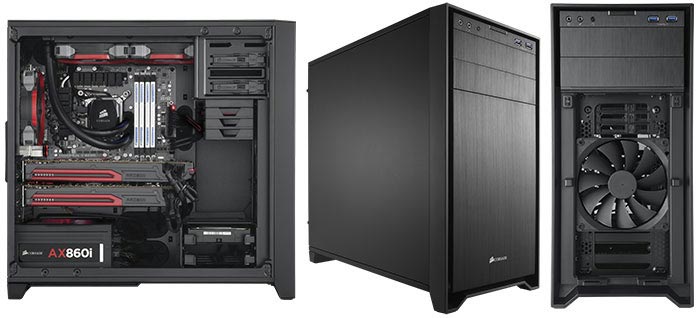
The Corsair Obsidian 350D is a miniature of the Obsidian 900D and is priced much better than the 900D. While the 900D is a Super Tower Chassis that can house as much components as you could possibly imagine, the 350D on the other hand is smaller than mid-tower cases which makes it ideal for building systems for traveling. I personally travel quiet a lot during the week so this is the perfect case for me at the moment. Also, the tool-free feature that this case has makes it super easy to make any changes to your case.
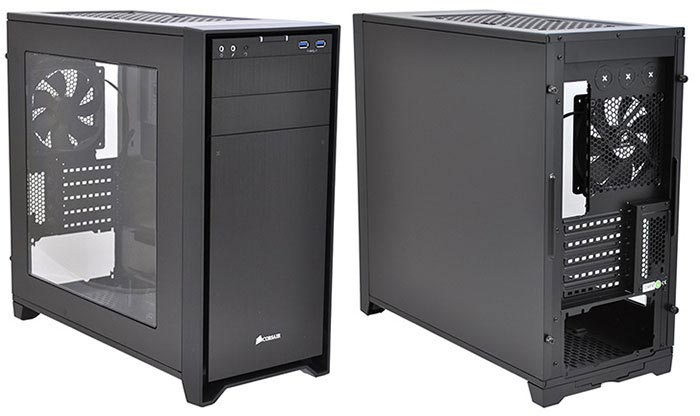
Corsair has made two models of the Obsidian 350D. You have the first model that is all steel chassis that is painted black throughout with no side window and costs only $89.99. And then there's the second model which is exactly the same as the first one but the only difference is that you have a nice big window on the side panel and costs $99.99.
The Obsidian 350D is designed for both water cooling and air cooling users in mind. If you are big on air cooling, the 350D supports up to five fans total which is more than what some other mid-tower cases can support. If you want to go full water cooling then the 350D has you covered too. The 350D gives you the option of putting a 240mm or 280mm radiator on top and a 240mm radiator on the front and even a 120mm on the back. The design team at Corsair has thought of all the possible options. If you look back at previous Corsair's cases, you will notice that Corsair has possibly the best design team when it comes to giving users as much control over their cases as possible.
Technical Specifications & Packaging
| Corsair Obsidian 350D Specifications | |
|---|---|
| Manufacture: | Corsair |
| Model: | Obsidian 350D |
| Dimensions: | 17.7" x 8.3" x 17.3" |
| Weight: | 13.3 lbs |
| MB Support: | Micro ATX, Mini ITX |
| Expansion Slots: | 5 |
| Form Factor: | Mid-tower |
| Clearances: | Maximum ATX PSU length 180mm Maximum GPU length 380mm Maximum CPU Cooler Height 160mm |
| Material: | Brushed Aluminum and Steel |
| Drive Bays: | Two 2.5”, Two 3.5” and Two 5.25” tool free drive bays. |
| Radiator Support: | Top: 240mm or 280mm radiator Front: 240mm radiator Rear: 120mm radiator |
| Cooling: | Front 140mm Rear 120mm cooling fans. Room for up to five fans total. |
| Front I/O: | Dual USB 3.0 ports |
| Power Supply: | ATX (not included) |
| Warranty: | 2 Years |
One thing that I have to mention before we move on is that according to Corsair's specs, the 350D is considered a mid-tower case but the 350D can only take Micro ATX or Mini ITX motherboards. The case is 17.7" tall, 17.3" deep and 8.3" in width. We'll talk more about the design of the case in the next page.
Moving on to the packaging, the front of the box has the name '350D' in huge bold text as well as an outline of 'Obsidian Series'. The box also lists some of the features of the case such as Compact Size, Superior Expandability and Flexible Cooling Options.
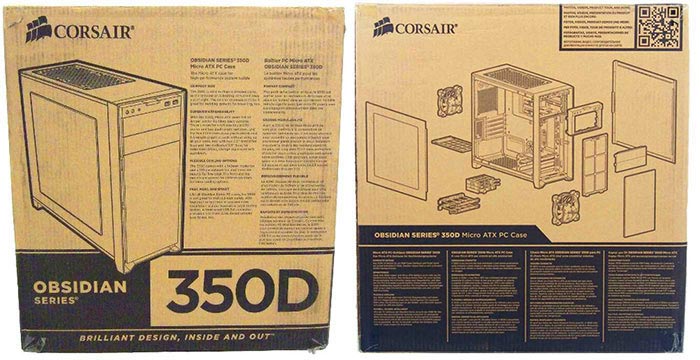
When opening up the package, you are presented with a high density foam that securely holds the case in place and is well protected during shipping. The case itself is wrapped up in plastic to prevent any accidental scratches during shipping.
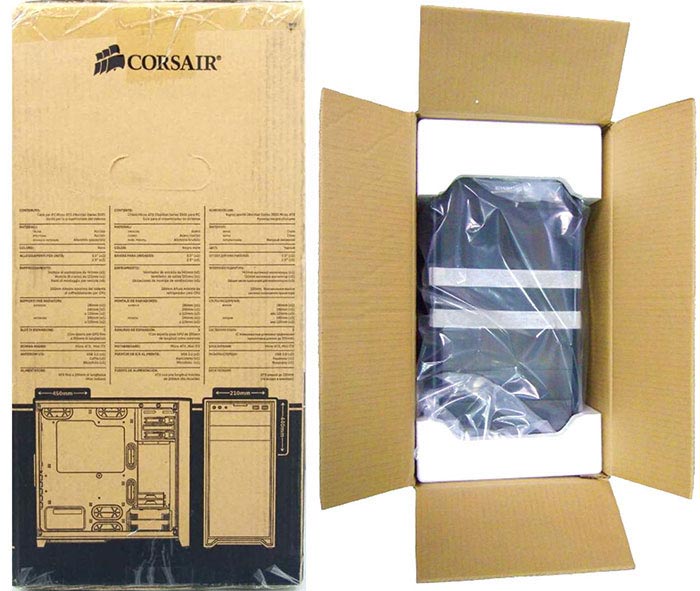
Along with the case, you will get a quick start guide that has all the information that you need to know about the case as well as a warranty information paper.
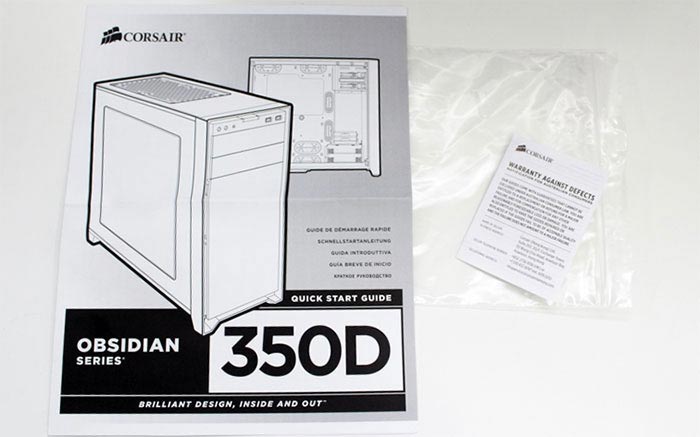
Design & Test Methodology
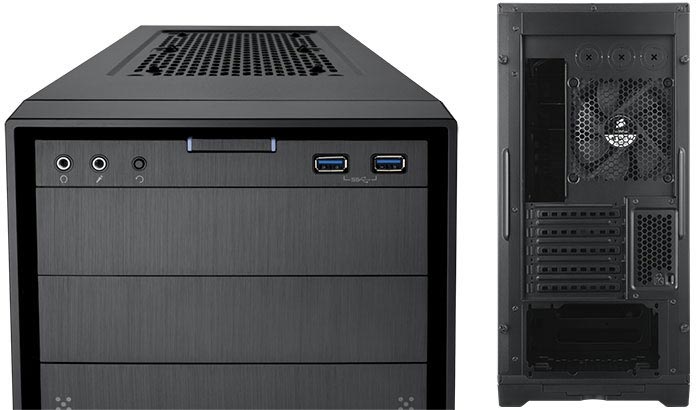
The 350D is made of steel except for its front panel which is made out of brushed aluminium. Corsair has always made sturdy cases and the 350D is no exception. Looking at the front side, we can see that there's room for two 5.25" bays, a pair of USB 3.0 ports, headphone and microphone jack and the power and reset buttons. The power button is the one in the middle and the reset button is right next to the microphone jack.
In my opinion, the reset button should have been closer with the power button so people don't accidentally press it when they are trying to hook up their microphone. The case has five expansion slots, a bottom mounted power supply, punch out holes for liquid cooling and thumb screws. The top of the case has a large grill that can be used to place a large radiator or two 120mm fans without a dust filter.
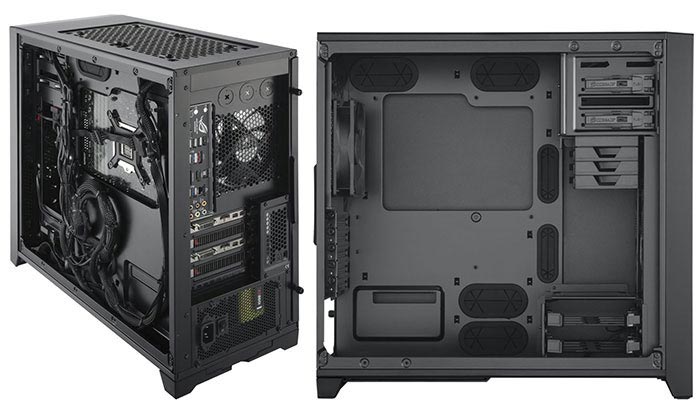
Corsair has given us a lot of room inside the 350D for cable management, a nice big hole to fit the backplate of a CPU cooler and rubber finish holes for running your cables through the back side of the case. The HDD cages can be removed and you can easily fit a large front radiator. There are large cable routing grommets below the motherboard mounts, next to the PSU, next to the motherboard and above the motherboard. The SSD drive cages that hang under the 5.25" drive bays are made of plastic and it is comprised of three SSD cages that clip together as a unit.
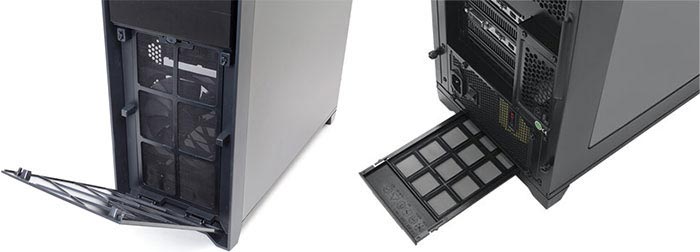
The brushed aluminium panel that sits below the optical drive, is attached with a push lock indent and a simple push using your finger will release the locks. When you remove the panel, you will see a dust filter and the front intake fan. There's a very large and deep gap around the front panel which offers lots of room to draw air through. The Obsidian 350D has plenty of mounting holes for either a dual 120mm, dual 140mm, or single 140mm fan setup on the front panel.
Most PSUs these days have bottom mounted intake fans and in most chassis, dust will slowly accumulate and block the airflow but Corsair has included a removable dust filter.
The dust filter is large and sturdy and slides out the back of the case and clicks into place so it won't fall out
when moving the case.
Without further ado, let's take a look at the test setup and methodology.
| Test Setup | |
|---|---|
| Processor: | Intel i7 3770K @ 4.6GHz 1.30v |
| Motherboard: | Asus Maximus V Gene |
| RAM: | Kingston HyperX 8GB @ 1866Mhz |
| Graphics Card: | EVGA GTX 680 |
| Storage: | Samsung 840 Pro 256GB |
| Power Supply: | Antec Earth Watts 650W |
| Heatsink: | Noctua NH-U14S |
| OS: | Windows 7 64Bit |
| Thermal Compound: | Noctua NT-H1 |
| Case: | Corsair Obsidian 350D Antec Three Hundred SilverStone PS08B |
To test the thermal performance of the Obsidian 350D, we will be testing the temperature of both the CPU and GPU during idle and load phases. We will be testing it with our regular testing setup and that is with a Intel Core i7-3770K overclocked to 4.6Ghz with using around 1.30 volts. This will be a good way to test the thermal performance of this case because we all know that Ivy Bridge runs super hot once overclocked and it really puts a lot of heat into any case.
All of the testing is done with an ambient temperature of ~19C. RealTemp will be used to monitor the temperature of the CPU and Prime95 (Large FFTs) will be used to deliver the full load to the CPU for 20 minutes. We'll run FurMark for also 20 minutes to put as much load into the GPU as possible.
Idle temperatures will be measured after leaving the computer idle for 20 minutes. CPU-Z will be used to verify the CPU speed and the voltage being used in Windows 7 and GPU-Z will be used to monitor the temperature of the video card.
One thing that I have to say before the test is that I'm using 1.30 volts for the overclock but you clearly don't need 1.30 volts to get the 3770K stable at 4.6Ghz but I'm doing this to stress test the cooler so it outputs as much heat as possible into the case. You can easily get it stable with using ~1.25 volts and you will probably get much better temperatures than I did so keep that in mind.
Results
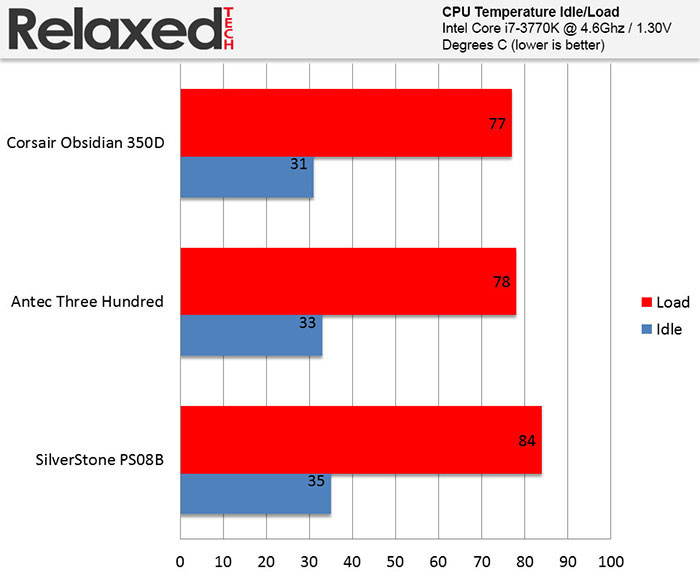
Here we can see how well the 350D does with the CPU temperature both in idle and under full load. The Obsidian 350D and the SilverStone PS08B are both Micro ATX chassis while the Antec Three Hundred is a mid tower case. Surprisingly, the 350D manages to come on top and beat both the Antec Three Hundred and SilverStone PS08B in idle and under full load temperatures.
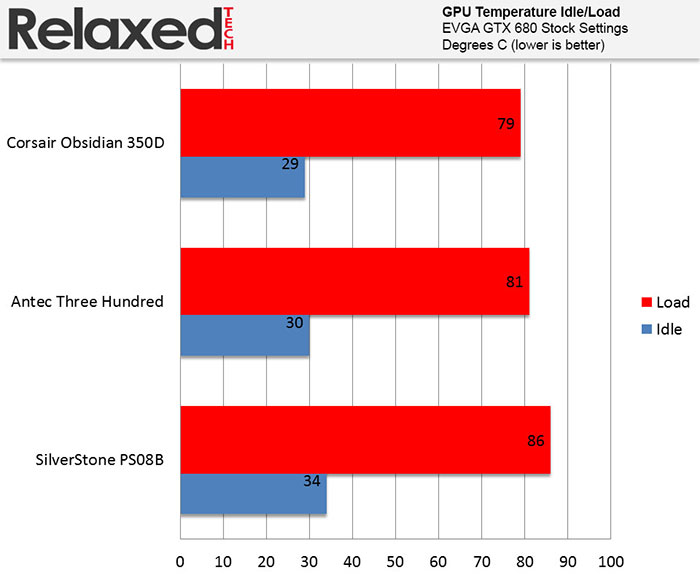
The Obsidian 350D also does very well with GPU load. Both idle and under load temperatures were better on the Obsidian 350D which shocked me because Antec Three Hundred has an extra 120mm fan and it still doesn't perform as good as the 350D. The airflow must be really good on the 350D because both the CPU and GPU seem to have lower temperatures using this chassis.
Conclusion
Corsair has a great product on their hands with the Obsidian 350D. Corsair is known for making high quality cases and the 350D is no exception. The quality is as you would expect top notch. The design team at Corsair has a done a fantastic job at making a near perfect case with absolutely little to no flaws. The only flaw that I could find (nitpicking here, really) is that there's no dust filter on the top grill and the SSD cage construction feels cheap. I'm not sure why Corsair decided to not put a dust filter up there since they already put one on the front panel and one on the bottom.
Pros:
+ Excellent Cable Management
+ Rubber Grommet Pass Through
+ Plenty of Room For Full Size Graphics Card
+ Tool Less Design
+ Dust Filters
+ Cheap
+ Flexible Fan and Radiator Mounting Options
+ Top-Notch Build Quality
Cons:
- No Dust Filter On The Top
- SSD Cage Construction Feels Cheap
The Obsidian 350D provides plenty of room for graphics cards up to 380mm, CPU coolers up to 160mm and PSUs up to 180mm in length.
Mounting HDDs/SSDs couldn't get any easier than this and that's all thanks to Corsair's Tool-Less design.
All you have to do is push the HDD/SSD into the mount and you're done.
The dust filters that Corsair has included are easy to remove and reinstall for quick cleaning.
The cable management and the airflow is excellent on the 350D. The amount of radiators you could install in this case is literally mind blowing. With the option of putting a 280mm radiator on the top, a 240mm radiator on the front and a 120mm radiator on the back, the Obsidian 350D easily puts other cases to shame.
Corsair has designed a great case while still pricing it a lot lower than what they usually do with their cases. If you are planning on building a high end gaming rig or a budget system based on an ITX or mATX motherboard, then the Obsidian 350D is most likely the right case for you. At $99.99 on Amazon, this case is a steal. With the amount of features that Corsair has provided us, this case easily deserves our Editor's Choice Award.
Final Score 9.0
